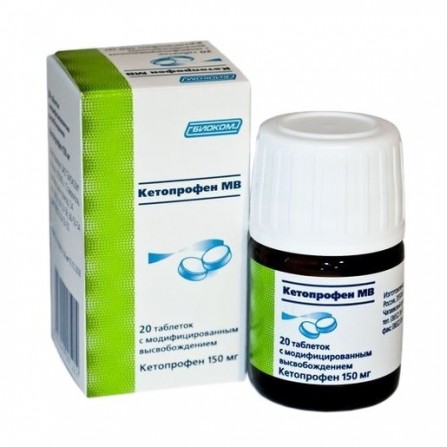Ketoprofen mv pills with mod. high 150mg N20
Condition: New product
1000 Items
Rating:
Be the first to write a review!

More info
Active ingredients
Ketoprofen
Release form
Pills
Composition
Ketoprofen 150 mg
Pharmacological effect
NSAID, a derivative of propionic acid. It has an analgesic, anti-inflammatory and antipyretic effect. The mechanism of action is associated with the inhibition of the activity of COX - the main enzyme in the metabolism of arachidonic acid, which is a precursor of prostaglandins, which play a major role in the pathogenesis of inflammation, pain and fever. (due to inhibition of prostaglandin synthesis in the central and peripheral nervous system, as well as the effect on the biological active nce other neurotropic substances that play a key role in the release of mediators of pain in the spinal cord). In addition, ketoprofen has anti-bradykinin activity, stabilizes lysosomal membranes, causes significant inhibition of neutrophil activity in patients with rheumatoid arthritis. Suppresses platelet aggregation.
Pharmacokinetics
When taken orally and rectally, ketoprofen is well absorbed from the gastrointestinal tract. Cmax in plasma when taken orally is achieved in 1-5 hours (depending on the dosage form), when administered rectally, after 45-60 minutes, in a / m administration - in 20-30 minutes, in / in the administration - in 5 minutes. ; Plasma protein binding is 99%. Due to pronounced lipophilicity quickly penetrates the BBB. Css in plasma and cerebrospinal fluid persists from 2 to 18 hours. Ketoprofen penetrates well into synovial fluid, where its concentration 4 hours after ingestion exceeds that in plasma; Metabolized by binding to glucuronic acid and to a lesser extent due to hydroxylation .; Excreted mainly by the kidneys and to a much lesser extent through the intestines. T1 / 2 ketoprofen from plasma after oral administration is 1.5-2 hours, after rectal administration - about 2 hours, after i / m administration - 1.27 hours, after intravenous administration - 2 hours.
Indications
Articular syndrome (rheumatoid arthritis, osteoarthritis, ankylosing spondylitis, gout); symptomatic treatment of inflammatory-degenerative diseases of the musculoskeletal system (periarthritis, arthrosinovitis, tendonitis, tendosynovitis, bursitis, lumbago), back pain, neuralgia, myalgia. Uncomplicated injuries, in particular sports, sprains, sprain or rupture of ligaments and tendons, bruises, post-traumatic pain.As part of a combination therapy of inflammatory diseases of the veins, lymph vessels, lymph nodes (phlebitis, periphlebitis, lymphangitis, superficial lymphadenitis).
Contraindications
For oral administration: erosive and ulcerative lesions of the gastrointestinal tract in the acute phase, "aspirin triad", marked impairment of liver and / or kidney function; III trimester of pregnancy; age up to 15 years (for retard pills); hypersensitivity to ketoprofen and salicylates.; For rectal use: proctitis and rectal bleeding.; For external use: weeping dermatosis, eczema, infected abrasions, wounds.
Use during pregnancy and lactation
Contraindicated for use in the III trimester of pregnancy. In the first and second trimesters of pregnancy, the use of ketoprofen is possible in cases where the potential benefit to the mother outweighs the potential risk to the fetus. If necessary, the use of ketoprofen during lactation is recommended to stop breastfeeding.
Dosage and administration
Set individually, taking into account the severity of the disease. For oral administration for adults, the initial daily dose is 300 mg in 2-3 doses. For maintenance treatment, the dose depends on the dosage form used. For the treatment of acute conditions or the relief of exacerbation of a chronic process, 100 mg is administered as a single intramuscular injection. Further, ketoprofen is applied orally or rectally.; Outer - applied to the affected surface 2 times / day; Maximum dose: when taken orally or rectally - 300 mg / day.
Side effects
On the part of the digestive system: epigastric pain, nausea, vomiting, constipation or diarrhea, anorexia, gastralgia, abnormal liver function; rarely - erosive and ulcerative lesions of the gastrointestinal tract, bleeding and perforation of the gastrointestinal tract. From the side of the central nervous system: headache, dizziness, tinnitus, drowsiness. From the urinary system: renal dysfunction. Allergic reactions: skin rash; rarely - bronchospasm.; Local reactions: when used in the form of suppositories, irritation of the rectal mucosa, painful defecation; when applied in the form of a gel - itching, skin rash at the site of application.
Overdose
With ketoprofen overdose, like other nonsteroidal anti-inflammatory drugs, nausea, vomiting, vomiting with blood, abdominal pain, melena, impaired consciousness, respiratory depression, convulsions, impaired renal function and renal insufficiency may occur. There is no specific antidote. Treatment is symptomatic.The effects of ketoprofen on the gastrointestinal tract can be reduced by using H2 receptor antagonists, proton pump inhibitors and prostaglandins. Shown gastric lavage and the use of activated carbon.
Interaction with other drugs
With simultaneous use of ketoprofen with other NSAIDs increases the risk of erosive and ulcerative lesions of the gastrointestinal tract and bleeding; with antihypertensive drugs (including beta-blockers, ACE inhibitors, diuretics) - it is possible to reduce their action; with thrombolytics - increased risk of bleeding.; With simultaneous use with acetylsalicylic acid, ketoprofen can decrease the binding of plasma proteins and increase its plasma clearance; with heparin, ticlopidine - increased risk of bleeding; with lithium preparations - it is possible to increase the lithium concentration in the blood plasma to toxic by reducing its renal excretion. With simultaneous use with diuretics, the risk of developing renal failure due to reduced renal blood flow due to inhibition of prostaglandin synthesis and against the background of hypovolemia increases. with probenecid, a decrease in ketoprofen clearance and its binding to plasma proteins is possible; with methotrexate - may increase the side effects of methotrexate.; With the simultaneous use of warfarin may develop severe, sometimes fatal bleeding.
special instructions
With extreme caution used in patients with liver and kidney diseases, gastrointestinal diseases in history, dyspeptic symptoms, immediately after serious surgical interventions. In the process of treatment requires systematic monitoring of liver and kidney function.


